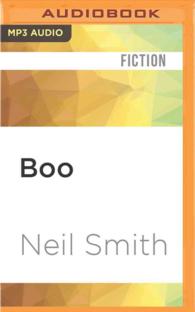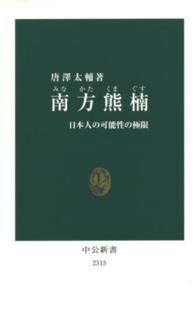- ホーム
- > 洋書
- > 英文書
- > Transportation
Full Description
According to the National Highway Traffic Safety Administration, "of the nearly 9.1 million passenger car, SUV, pickup and van crashes in 2010, only 2.1% involved a rollover. However, rollovers accounted for nearly 35% of all deaths from passenger vehicle crashes. In 2010 alone, more than 7,600 people died in rollover crashes."
Rollover accidents continue to be a leading contributor of vehicle deaths. While this continues to be true, it is pertinent to understand the entire crash process. Each stage of the accident provides valuable insight into the application of reconstruction methodologies.
Rollover Accident Reconstruction focuses on tripped, single vehicle rollover crashes that terminate without striking a fixed object. Topics featured in this book include:
Analysis methods through various accident phases, including advanced simulation
Vehicle event data recorder usage
Occupant ejection during rollover crash
The goal of this title is to break down the various phases of a rollover crash to analyze each stage for use in the reconstruction process - to the greater understanding of crash analysts, consultants and safety engineers alike.
Contents
CHAPTER 1
Overview of Rollover Reconstruction
General Speed Analysis Approach
Vehicle Geometry and Inertial Parameters
Overview of Rollover Test Procedures
Dolly Rollover Tests
Rollover Tests Using Modified Dolly Fixtures
Rollover Tests Using Automated Steering Control
Controlled Rollover Impact System
Real-World Rollovers
CHAPTER 2
Physical Evidence from Rollover Crashes
Scene Evidence
Vehicle Evidence
Scene and Vehicle Documentation Checklists
Site Inspection Checklist
Vehicle Inspection Checklist
Photogrammetry
Rectification
Camera Matching
Camera Reverse Projection
PhotoModeler
References
CHAPTER 3
Analysis Methods: Rollover Phase
Average Deceleration Rates
Determining Likely Number of Rolls from Roll Distance
Typical Rollover Characteristics
Mathematical Analysis of the Orientation of Scratches on the Vehicle
Reconstruction Methodology - Roll CRASH Model
Comparison to Full-Scale Tests
Critical Speed Analysis
Coefficient of Friction
Case Study: Asay's Isuzu Rodeo Rollover Test (Test #2,2010-01-0521)
CHAPTER 7
Analyzing Tire Mark Striations
Mechanisms That Create Striation Evidence
What Can Striations Tell Us?
Models for Analyzing Striations
Slip Angle from Striations (Steering)
Longitudinal Slip from Striations (Braking)
Tire Mark Striations - Sensitivity and Uncertainty Analysis
Case Study - Striation Analysis
References
CHAPTER 8
Error Rates of the Speed Analysis Methods
Reconstructions of the Crash Tests
Discussion of Reconstruction Results
CHAPTER 9
Advanced Analysis Methods: Simulation
Introduction
Human Driver Steering Capability
Prior Studies Related to Simulating Rollover Crashes
HVE
PC-Crash
Studies Describing the Conceptual Models
Operational Validation/Calibration Studies
Studies that Assume the Validity of PC-Crash
Suspension Parameters for PC-Crash
Simulation of Asay's Isuzu Rodeo Test
CHAPTER 10
Event Data Recorders in Rollover Reconstruction
EDR Data: Loss-of-Control Phase
Speed Reported by Passenger Car EDRs
Effects of Sideslip
Analysis of EDR Data from the Loss-of-Control Phase
EDR Data: Trip and Roll Phases
CHAPTER 11
Analyzing Occupant Ejections for Rollover Crashes
The Motion of Ejected Occupants
Applying the Occupant Ejection Model
About the Authors








